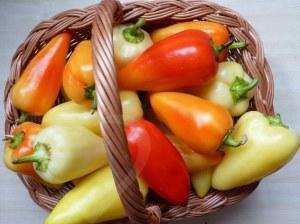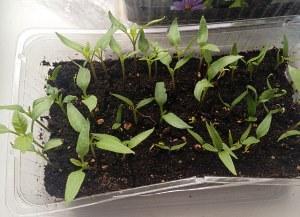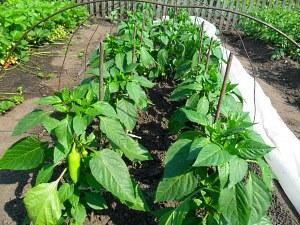Growing bell pepper: the secrets of success
 Caring for bell peppers in the country and in the garden is a favorite pastime of most gardeners. If you choose the right variety, grow healthy seedlings and carefully look after her, then the multi-colored bushes in the garden will generously thank their owner.
Caring for bell peppers in the country and in the garden is a favorite pastime of most gardeners. If you choose the right variety, grow healthy seedlings and carefully look after her, then the multi-colored bushes in the garden will generously thank their owner.
Growing a rich harvest of bell peppers on a personal plot is not as easy as it seems at first glance. The main problem that gardeners face when growing this vegetable is the bitterness of the fruit. It's a shame when you mess around with planting seedlings, regularly water and feed the plant, protect it from pests and diseases, and as a result you get beautiful, juicy, but inedible fruits. Quite often, instead of the expected variety, small twisted stumps grow on the bush.
How to deal with such phenomena? It's very simple: buy bell pepper seeds from a company with good recommendations and grow seedlings yourself.
Bell pepper seedlings on the windowsill

Seeds sown on time and correctly will give friendly and strong shoots. In order for the seedlings to please their owners, you need to remember a few rules:
- The best time for sowing early February... Pepper seedlings have time to get stronger before planting in the open field and build up a powerful root system.
- Before sowing, seeds must be soaked in a strong solution of potassium permanganate, kept for 15 minutes, rinsed under running water and processed for 12 hours growth stimulant.
- After treatment with a stimulant, it is advisable to put the seeds on a damp cloth and place in mini greenhouse.
- After swelling, high-quality seeds suitable for planting are clearly visible.
- Sowing must be done in sterile soil. Do not rely on purchased soil. It can also become infected with infectious bacteria. The best proportion of soil for planting bell peppers is a 1: 1 mixture of peat, garden soil and sand. The ground mixture should also be watered with a strong solution of potassium permanganate.
- Sowing is carried out in moist soil in small furrows no deeper than 1.5 cm. The soil is compacted with a spatula or palm. The container is placed in a mini-greenhouse or covered with foil.
- Pepper is very thermophilic and seeds need high temperature and humidity for germination. Until the ground in the container warms up to +25 degrees, seedlings will not appear. This is important to know if swollen seeds are planted, which can rot in the soil at a lower temperature. If the temperature is lower, then the first shoots can be expected for a very long time or not at all.
- After the first shoots appear, the greenhouse must be ventilated every day for half an hour and the temperature must be reduced to +22 degrees so that the plants do not stretch out. Watering the seedlings at this time is not recommended.It is better to spray them with warm water from a spray bottle. Water procedures can be carried out on cloudy days, or remove the container with seedlings from the light so as not to burn delicate seedlings.
- At temperatures below +20 degrees, the seedlings stop growing. On cloudy days, it is advisable to place the plants under lamp.
- After the appearance of the second real sheet, you can proceed to picking... Plants are watered abundantly two hours before the start of the procedure. This technique reduces trauma to the root system. The ideal option is transplanting with a small clod of earth. Such seedlings quickly take root and start growing. If the plant has long roots, then it is advisable to shorten them, but only the part that is not covered with soil. After the pick. Seedlings are watered no earlier than five days later.
Bell pepper care
 The process of growing bell peppers in the open field is no less important than working with seedlings. If you take it responsibly, then in the fall, small bushes will delight you with a rich multi-colored harvest. Bell pepper care includes regular watering, weeding, loosening the soil, feeding and collecting fruits to the extent of their ripeness. The pepper is planted according to the scheme 40 cm by 40 cm. Such thickened plantings are characteristic of this plant and have a beneficial effect on its growth.
The process of growing bell peppers in the open field is no less important than working with seedlings. If you take it responsibly, then in the fall, small bushes will delight you with a rich multi-colored harvest. Bell pepper care includes regular watering, weeding, loosening the soil, feeding and collecting fruits to the extent of their ripeness. The pepper is planted according to the scheme 40 cm by 40 cm. Such thickened plantings are characteristic of this plant and have a beneficial effect on its growth.
Pepper is not only a thermophilic plant, but a big drinker. Water the plant with warm water in the evening. On hot days, daily watering will not be superfluous.
Once a week, after abundant watering, the plants are fed organic fertilizers... Trace elements can be added no more than once every two weeks.
Growing sweet bell peppers in a greenhouse is no different from growing them outdoors. The only difference is that for greenhouses tall varieties that require a garter or support are also suitable. Peppers feel more comfortable in the greenhouse, as they like warmth and moisture.
The best varieties of bell peppers
 It's pretty hard to define today the best varieties bell peppers among the large assortment offered to gardeners by domestic and foreign manufacturers.
It's pretty hard to define today the best varieties bell peppers among the large assortment offered to gardeners by domestic and foreign manufacturers.
Among the long proven varieties, it should be noted:
- California Miracle
- "Gift of Moldova",
- "Orange miracle".
These varieties feel great in open ground and in film shelters.
Among modern varieties, they proved themselves worthy:
- "Czardas",
- "Shorokshary" (improved California Miracle),
- "Cornet",
- "Triton",
- "Marinkin tongue"
- "Ivanhoe",
- "Fat Baron"
- "Italian Boot".
Red bell peppers in modern breeding have received many relatives who can boast of yellow, orange, black, white, purple colors and will help create a multi-colored carnival on the garden bed.
Diseases and pests of bell pepper
A common disease of bell pepper seedlings is black leg. It appears with thickened plantings and with non-observance of agricultural technology:
- frequent overflow of soil;
- lack of daily ventilation;
- low room temperature.
When infected with a black leg, 80% of the seedlings die, so it is better to adhere to the rules for preventing the disease:
- process the seeds before planting in a solution of potassium permanganate;
- destroy problem seedlings;
- disinfect the soil.
At the first signs of the disease, the soil is watered with a solution of copper sulfate (3%).
Top rot affects young bushes that lack calcium. Excess may also be the cause nitrogen in the soil, irregular watering, sudden changes in humidity in the air. The disease manifests itself in the form of watery spots on the fruit, which dry out after a few days. The infection can be overcome quickly and effectively. It is worth spraying or feeding the pepper bushes with calcium nitrate or calcium chloride, as the plants quickly return to normal and continue to develop.To prevent the disease, it is necessary to control the amount of nitrogen in the soil and watering.
When the plant withers, leaves turn yellow and curl, these are sure signs of fusarium wilt. If you do not take action, then in a few days the bush will die. The peak of the disease falls at the time of fruit setting. There is no cure for this infection. The only way out is to remove the diseased plant and destroy it. To prevent the disease from visiting vegetable beds, they must be kept clean of weeds, and the soil must be loosened regularly.
Septoriosis appears as white spots on the leaves of the plant and is capable of destroying half of the crop in a few days. To cope with the problem will help "Trichodermin", "Fitosporin".
The most dangerous pest of bell peppers is the whitefly. You can get rid of it only with the help of chemicals. Biological agents are only effective if the plants are grown outdoors.

Diseases and pests of bell pepper can be defeated if you adhere to the rules of growing a plant and observe the vegetation of green pets. Daily observation will help you quickly find the problem and remove it. But how to grow bell peppers in the country? Urban residents do not have the opportunity to often walk in the beds and in order not to lose most of the harvest, it is necessary to adhere to preventive measures, starting with sowing seeds. It is good if it is possible to grow peppers under a film cover. This will help to avoid many problems during the absence of the owners and protect the plants from hail, hot sun rays, hypothermia and strong winds.
When is the best time to sow peppers for seedlings? - read in our article!